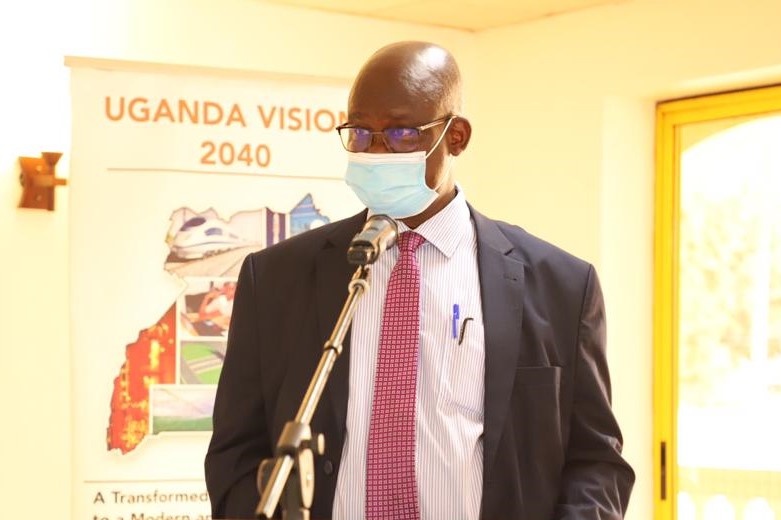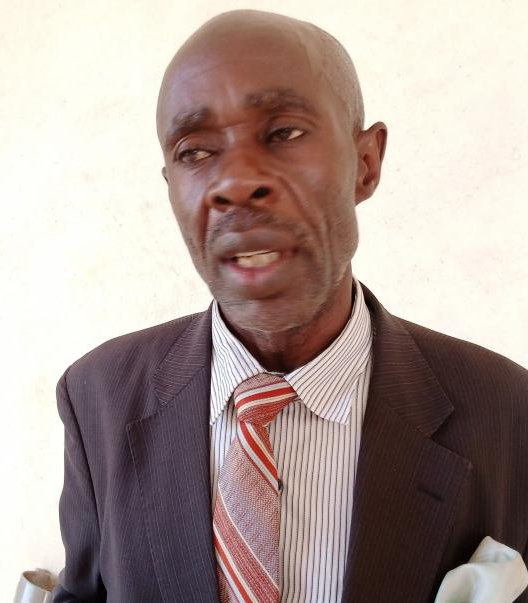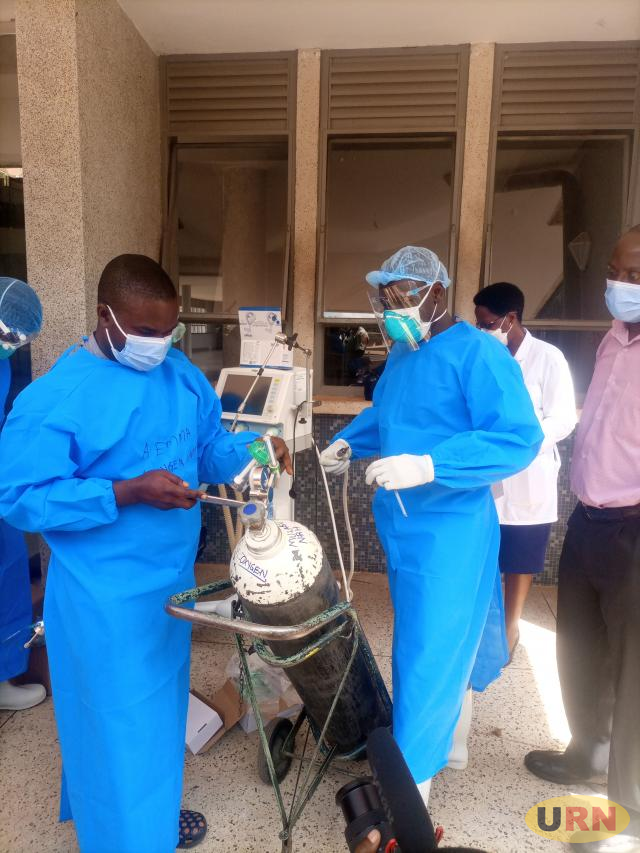PA Deputy Chairman, Prof. Sam Kinyera Obwoya
By Francis Otucu
The National Planning Authority (NPA) says as of 2012-2013, Uganda’s life expectancy stood at 50.4.
NPA’s deputy Chairman, Prof. Sam Kinyera Obwoya, says the authority had to set a target of 60.
However, while presenting the deliverables in the 2016-2021 NRM manifesto, Prof. Obwoya said the life expectancy has increased to 63, surpassing the target.
He did not give factors for this increase.
However, figures show that between 2012 and 2020, the country’s value of exports increased from USD 4,993.2 million in FY2012/13 to USD 5,475.7 Million in FY2019/20.
“This is in line with the government strategy of export promotion,” he said.
To this, Obwoya says it is worth noting that the country has made progress towards the realization of the middle income status which he said is a major focus of NDPIII.
But as part of the planning process, NPA carried out an assessment to establish the challenges that were still outstanding on the basis of which NPDIII was produced in the last year of the Manifesto implementation.
“That assessment process recognized the fact that we did not achieve growth and the quality of life targets as anticipated in NDPII. For instance, there is poverty reversal from 19.7% to 21.4%, the COVID-19 pandemic and natural disasters which affected the performance of the productive sectors,” he said.
The challenges identified include:
Youth bulge
The NPA says the Youth constitutes more than 50% of the population. However, it says, the youth bulge has both positive and negative consequences associated with the demographic dividend. By investing in the youth, NPA says the country will have a productive labor force that will contribute to economic growth and that requires inputs into education, skilling and mindset change in addition to provisions for health and their involvement in economic activities. Conversely, the NPA notes that this puts pressure on the budget since investments will be redirected towards provision of social services against the investments in the productive sector.
High cost of electricity
NPA reports that progress has been made in reduction of the cost of electricity over the last 4 years from 9 cents to 8 cents and from 16 cents to 9.8 cents for extra-large and large industrial consumers respectively. However, they say it is still higher than the target of 5 cents per Unit. The cost is even higher for medium industrial consumers at 15.6 cents for a unit and for commercial consumers (cottage industries) at 17.5 cents per unit.
Persistent vulnerabilities and wide-regional disparities in attaining required poverty reduction targets. The percentage of people living below the poverty line (1.00 USD per day) was 21.4% in FY2017/18 compared to NDPII target of 14.2%. Moreover, there are wide regional disparities with Bukedi (47%), Busoga (42%), Bugisu (40.7%) and Teso (25%) experiencing reversals compared to the previous poverty levels.
Labor market skills mismatch
NPA says the education and training system produces skills different from those required by the market. With the industrialization drive, there is for example, high demand for internationally certified technical and craftsmanship skills, which are not available on the market.
Limited access to and high cost of capital
The NPA admits that there are high interest rates and high collateral requirements. It adds that the main source of development finance for businesses is short-term credit mainly from commercial banks where lending rates average 20%. Furthermore, 20% of the adult population in 2018 access financial services informally while 22% have no access at all.
Low capacity in public service and prevalence of corruption
NPA says the Civil service is weak and not adequately equipped to drive development. For instance, NPA says a number of project ideas that were included in NDPII have not been implemented.
“There are reported leakages of public resources as evidenced from Auditor General’s reports and Inspectorate of Government investigations. These two combined have affected effectiveness and efficiency in government and partly this explains why a number of project ideas that were included in NDPII have not been implemented,” Obwoya said.
Continued reduction in the forest cover as well as wetland degradation and encroachment. NPA says the forest cover reduced to 9.5% in FY17/18 from 20% in 1986/87 while wetland cover reduced from 13% to 10.9% over the same period.
“The implication is increased vulnerabilities and disparities in incomes as well as loss of livelihood to the population and reduction in GDP growth rates,” Obwoya said.
Slow Project Implementation. Implementation of core projects have been slow, NPA says. Thus, adversely affecting growth and job creation. According to NPA, out of the 42 NDPII core projects, only 17 are on schedule, while 5 are under implementation but behind schedule. The rest are either at feasibility stage or have not yet started.
To address the above challenges, NPA says the following strategies have been identified and are elaborated in the NDPIII and the NRM Manifesto, 2026.
(i) Maintaining a stable macro-economic environment: through among other things sustaining a stable exchange rate regime; inflation targeting to ensure low and stable prices; maintaining a stable fiscal policy, and pursuing policies designed to lower interest rates.
(ii) Reducing cost of doing business: through increasing access to reliable, stable and affordable energy; Reducing transport costs through improving interconnectivity and regular maintenance of existing transport infrastructure stock; Reducing the cost and increasing reliability of Internet; etc
(iii) Reducing transport costs through improving interconnectivity and regular maintenance of existing transport infrastructure stock. It is recommended that the Government continues prioritizing investments in transport infrastructure to increase the Country’s competitiveness. In that regard, focus should be on increasing the connectivity within the country, region and the global markets.
(iv) Import Substitution and Export Promotion Strategy through completing the development of at least one industrial site in each of the 18 zones of the country to fully serviced Industrial Parks; All wealth creation funds should be consolidated into one, and some of which should be used to capitalize the Uganda Development Bank
(v) Commercialization of agriculture: Agricultural sector contributes 26% of total GDP and forms the main export to our regional market. To generate sufficient production volumes to sustain domestic (food security) and external markets, it is critical that we commercialize agriculture focusing on: Organization of farmers into clusters to support them to produce reliably and consistently, Strengthening agricultural extension systems anchored at the parish as the planning and implementation level; Increasing use of water for production, mechanized irrigation, including water storage, Scaling up existing agricultural credit and guarantee schemes as a way of providing affordable agricultural finance and insurance;
(vi) Harnessing the Tourism potential: NPA says this can be achieved by improving tourism related infrastructure, Targeted development of tourism products Developing Skills essential for Tourism growth, increasing affordable accommodation in the tourist hotspots outside of the Greater Kampala Metropolitan Area, Aggressive marketing especially in non-traditional markets, increasing private sector access to cheap long-term credit, Strengthening regulation and enforcement of standards.
(vii) Promotion of Science, Technology, Engineering and Innovation: To realize this, NPA says there is need to; build science, technology, engineering and innovation infrastructure, provide hands-on-training of scientists at all levels; develop policy and institutional framework for importation of appropriate technology in order to reduce the research and development time and cost of investment; strengthen the legal framework around innovation to increase technology adoption and diffusion so as to maximize the number of innovations being translated into commercial products and thus the number of factories/jobs being started/created;
(viii) Mineral Beneficiation and Oil refining: It is, proposed that priority should be on fast-tracking interventions aimed at facilitating the exploration, extraction and processing of Oil and Gas as well as the mining and beneficiation of seven (7) minerals namely: Iron Ore, Phosphates, Copper, Gold, Marble/Limestone, Dimension Stones, and Sand/Aggregates.
(ix) Promote Private Sector Investment – Foreign Direct Investment and Domestic Investment: The proposed areas of focus include: strengthening institutions for development financing, for instance, recapitalizing UDB; strengthening the investment and industrialization role of government, for instance, through strengthening the role of UDC; reviving and strengthening the cooperative movement, including the cooperative bank; providing a wider range of long-term finance options at affordable rates in NDPIII priority areas e.g. agricultural finance; etc
(x) Mindset change to promote focus on development: Areas of focus include: Review of the mandates and coordination mechanisms of the agencies involved in these interventions with a view of improving their effectiveness and Implementation of a National Service programme to empower citizens with information to change their outlook on life and the opportunities it presents,
(xi) Exploiting opportunities of urbanization to drive growth: NPA says urbanization is a key driver of growth. 65% of non-agriculture GDP is generated by the Greater Kampala Metropolitan Area (GKMA), However, the potential of urbanization is constrained by; unplanned and uncoordinated developments and limited enforcement of existing regulations. To exploit the opportunities of urbanization the focus areas will be: Development of Physical, Spatial and Master plans for the regional and strategic cities as proposed in Vision 2040; Development of settlement plans around existing and planned industrial, mineral, science and ICT parks; etc
(xii) Increasing the stock of skilled, innovative and healthy populations. NPA says this should be done by: improving the quality of education at all levels e.g. through reduction of teacher to student ratios; leadership development for education managers; Operationalization of the recently reviewed national curriculum for secondary education; strengthening the link of higher education to industry for instance through internships, attachments, and involvement of industry practitioners in curriculum design to strengthen research, innovation and acquisition of practical knowledge; etc
(xiii) Increasing Domestic Revenue Mobilization: NPA recommends that government: Maintains a stable and predictable tax regime over the medium term given the consensus that the country has limited room for introducing new measures without overburdening the taxpayer; Strengthens the enabling environment for tax collection through for instance upgrading the eTax system, integrating data management systems across government, expanding the metrics used to assess URA performance, and addressing the perception of corruption among tax officials, and establishing a Tax Ombudsman; etc
(xiv) Promotion of Social Services based on the sub county-Parish model. NPA says the Parish Development Model (PDM) is the last mile strategy by the Government of Uganda for improving incomes and welfare of Ugandans at household level. It is an extension of the whole-of-government approach to development under NDPIII, with the Parish as the lowest administrative and operational hub for delivering services closer to the people and hence fostering local economic development.





